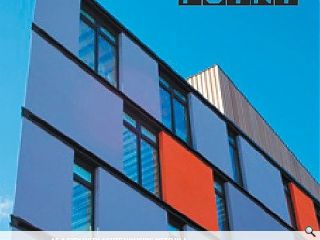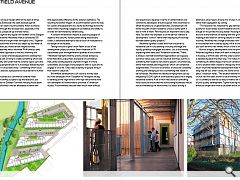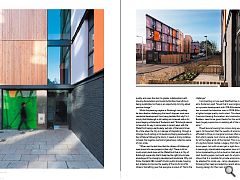Westfield Avenue
24 Oct 2012
As a city with acute housing need in a country in the midst of a housing crisis edinburgh needs all the new mixed-tenure housing It can get. It’s baffling therefore that we simply aren’t building anywhere near enough. We discuss this and other issues with 7N Architects Ewan Anderson, architect of Westfield Avenue. Photography BY Dave Morris
Development can be a fraught affair at the best of times, but in a city like Edinburgh the odds stacked against development can seem insurmountable. When a scheme does emerge through the red tape then, especially in the current climate, people sit up and take notice.A familiar sight to any regular rail traveller on the Glasgow to Edinburgh mainline Westfield Avenue constitutes 193 affordable homes and eight small workspace units. Together these have transformed a former bus depot by the Water of Leith into a mixed use, mixed tenure neighbourhood.
It is this waterway which informed 7N Architects (and Make before them) approach to the site, informing the positioning of a series of landscaped pavilions snaking their way across the plot. Striving to create something which had a distinct identity and urban feel the scheme opens up to the river by turning perpendicular to it, avoiding a deadening wall along the river in one swell swoop - something which could so easily have acted as a physical and visual barrier to further development.
Initially conceived as a commercial scheme these ambitions were swiftly put paid to by the recession, but opened the door to Dunedin Canmore Housing Association who duly transformed it into an affordable scheme with little appreciable difference to the exterior aesthetics. The resulting horizontal ‘fingers’ of accommodation point the way for cyclists and pedestrians to a newly built bridge across the water whilst imparting a degree of surveillance and safety to an area still dominated by warehousing.
A random fenestration imparts a surprising degree of depth to the colourful render panels along these access routes, a deliberate attempt to add a touch of modulation to the length of the facades.
Taking time out to give Urban Realm a tour of the development project architect Ewan Anderson of 7N expounded upon the regenerative qualities of the scheme: “Westfield highlights that the priority should always be brownfield land unless there are special circumstances that justify looking beyond city/town fringes. It’s more sustainable, encourages more people to walk or cycle and to engage in civic life. Cities need a density of people living in their heart to stay alive.”
Brownfield development is of course a worthy ideal but with developers from Chapelton to Tornagrain racing to develop prime virgin land to shift high value homes how can developers to incentivised to prioritise it? Anderson mused: “As brownfield sites are often much more difficult and expensive to develop in terms of contamination and constraints, developers should be given more incentives to offset the pressure on greenfield sites. Development will follow the path of least resistance unless a better path is laid in front of them. Planning has an important role to play here. Too often the emphasis is on the barrier method of development “control” rather than helping to pro-actively facilitate better quality projects.“
Westfield signifies a wider shift from industrial to residential use in a city battling a housing shortage and rapidly spiralling mortgages and rents - but is this merely displacing other land uses? Anderson observed: “There is always a risk that brownfield regeneration can squeeze out lower value uses, such as industrial activities, but this is something that needs to be tuned to specific circumstances, rather than blanket planning policies which can sometimes stagnate areas. The micro-economics of cities are constantly evolving and changing so this is something that needs to be harnessed. Westfield has retained employment uses by integrating 10,000 sq/ft of small business space into a largely residential scheme. A lot of work was done on controlling noise issues to ensure that the surrounding businesses would not be inhibited by the new homes. It’s about striking a balance as cities need a diverse mix of uses in close proximity rather than segregation by zoning.
“The recession has widened the gap between those who qualify for social rented accommodation and those who can still get on the private housing ladder. Housing Associations are now at the forefront of dealing with this growing problem, meeting a real need for working people on lower household incomes. Westfield has a range of tenures from social rented to mid-market rent to shared equity. All of it is tenure blind so you can’t tell who lives where, which is how it should be.”
Born as a legacy development from the private sector Westfield signifies a wider shift back to the public sector in housing, a shift at odds with the wider economy which is rebalancing back the other way. This makes housing something of a black sheep in terms of construction but it is not a situation that is liable to change any time soon. “The return of private residential development feels like it is still a long way off but, when it does, the world will be a different place”, Anderson notes. “The situation before the credit crunch has now been shown to be an entirely false position so it is unlikely to ever be so easy to make a lot of money out of poor quality development. Tighter funding regimes will enforce a longer term view to be taken which should improve quality and open the door to greater collaborations with Housing Associations and Local Authorities. Everything is being recalibrated so there is an opportunity to bring about positive change.”
Whilst the planning regime in Edinburgh can politely be described as challenging this hasn’t stopped most new residential development from being terrible. But why? Is it simply that Edinburgh is still resting on its laurels safe in its proud legacy architecture? Anderson said: “Edinburgh seems to have lost its way in some areas in recent years with the Waterfront being a particularly sad relic of the boom times. At a time when the City is in danger of stagnating, through a strange mix of resting on its laurels and being paralysed by a fear of failure following the trams, it needs a strong initiative to break the negative inertia and galvanise a collective sense of civic pride.
“When was the last time that the citizens of Edinburgh were proud of a new project in their city? There is still so much empty land down at the Waterfront that is in City of Edinburgh ownership that it feels like the right time to take advantage of the changing development landscape. Why not follow the Berlin IBA model? A bold, public/private, housing led, initiative to improve the quality of the city for all of its citizens. Something new that everyone is proud of. That is the challenge.”
Commenting on how well Westfield has met its design aims Anderson said: “Given that it was originally designed as a private development with 25% Affordable housing it has survived the transition over to 100% Affordable with a tighter budget pretty much intact. The client, Dunedin Canmore Housing Association, and contractor, Hart Builders, need to be given thanks for this as they have been hugely supportive in realising all of the key design aims.”
Mixed tenure housing has come a long way in recent years, to the extent that the quality of accommodation afforded to those on marginal incomes often exceeds that which people must stump up debilitating mortgages for at the higher ends of the market. This is symptomatic of a dysfunctional market, a legacy from the froth of the boom years, but with no end yet in sight for a sector adrift in seemingly interminable stagnation now is the time to be implementing a full re-boot so that we don’t just start building again, but build well. As a hybrid Westfield shows that it is possible for private accommodation to be adapted for social use… canny developers should be following their lead and adapting recent advances in social housing design for their own products.
|
|
Read next: Days of Destruction, Days of Revolt
Read previous: Speed of Light
Back to October 2012
Browse Features Archive
Search
News
For more news from the industry visit our News section.
Features & Reports
For more information from the industry visit our Features & Reports section.





